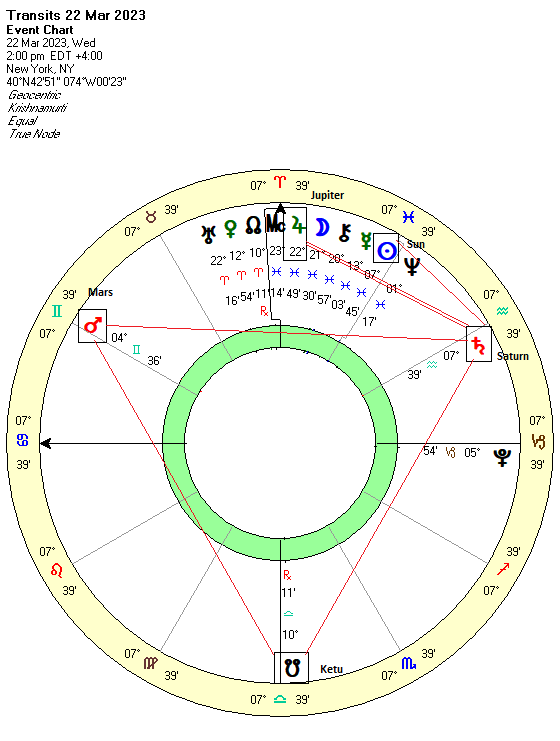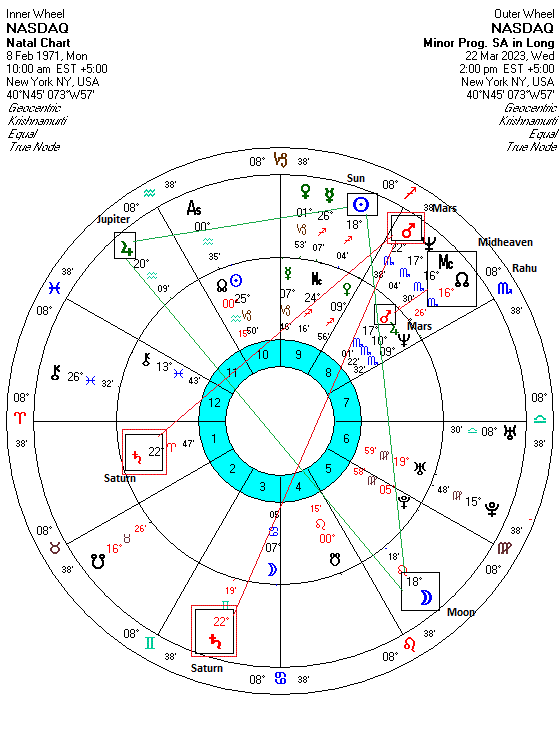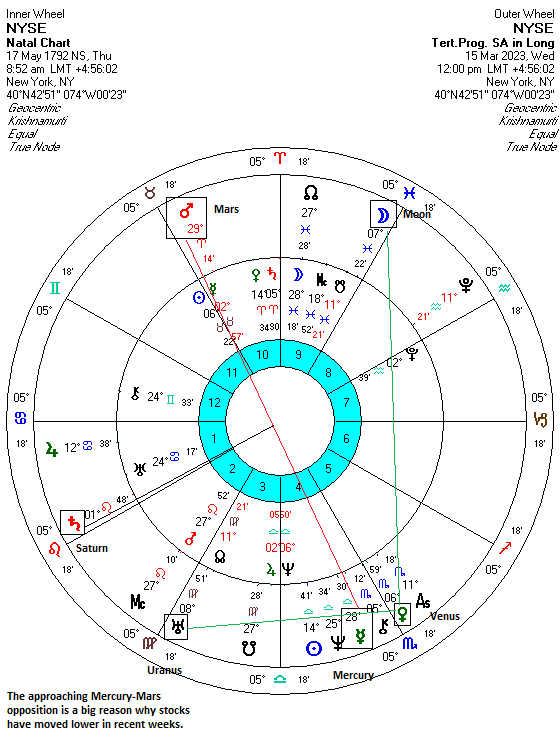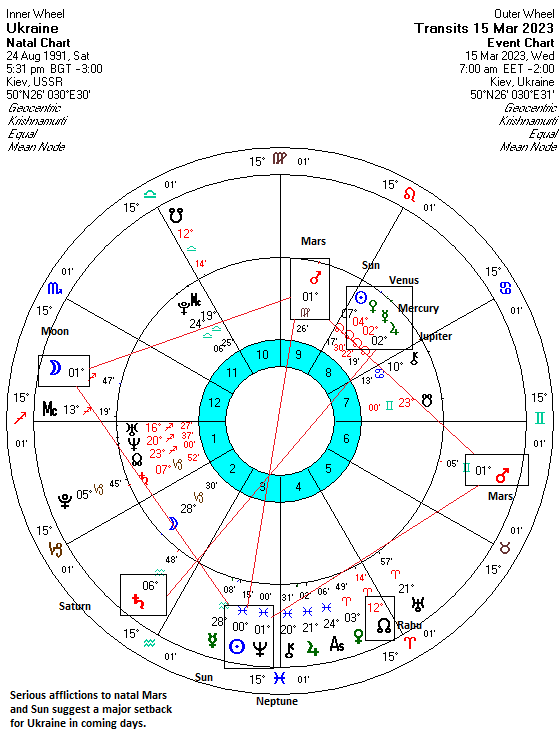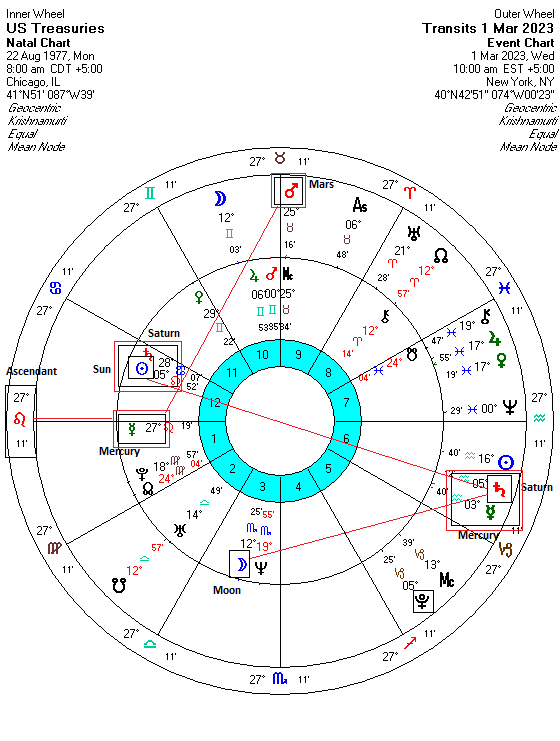(29 March 2023) US stocks have bounced in recent days as the banking crisis has faded from the headlines after a series of carefully-orchestrated bailouts and buyouts. The major indexes have been slowly pushing their way back up towards their early February highs. While the rebound has temporarily put on hold all the doom and gloom talk about the economy, we should note that stocks have basically moved sideways since November.
Following on my previous examination of the use of progressed cycles in natal charts, I thought we would explore how this timing technique can be used in the horoscope of the S&P 500 index. This is arguably the most important stock index in the world as it covers the 500 largest publicly-traded companies in the US. Founded in 1957, the S&P 500 provides an indispensable window on the fluctuations in collective sentiment that influence stock prices.
By way of example, we are focusing solely on the minor progressed chart. This progression is based on the lunar month such that the length of lunar month (29 days) is equivalent to one year of calendar time. The minor progressed chart cast for today (March 29, 2023) is derived from the planetary positions for February 11, 1962. The resulting 1:13 time compression provides a useful bridge between the often fast-moving transits and much slower progressions such as the day-for-a-year secondary progressions.
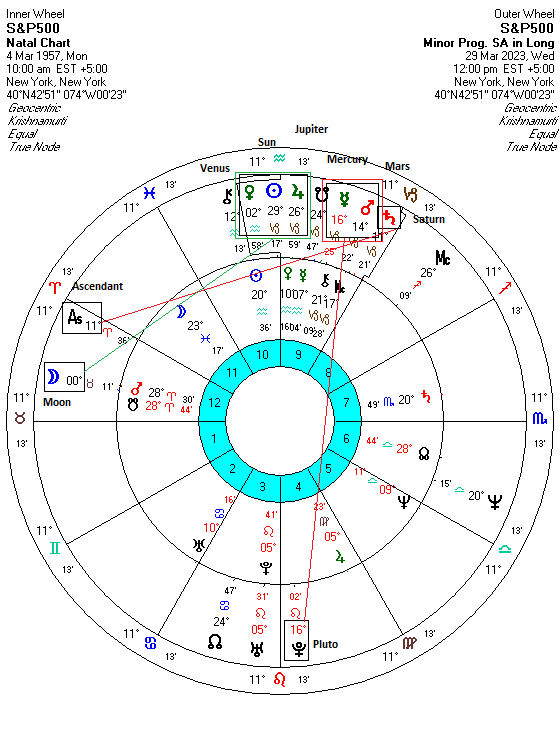
Looking at today’s progressed chart, we can see two potentially significant groupings of planets. At the top of the chart, is a conjunction of Venus, Sun and Jupiter. This is clearly a bullish arrangement which may partially explain the recent rebound in stocks. However, we should note that the faster-moving Sun (29 Capricorn) and Venus (2 Aquarius) are now clearly separating from Jupiter (26 Capricorn). This suggests that whatever the bullish influence of this triple conjunction, it is now likely on the wane. It is possible that the close 90-degree alignment with the Moon has recently activated another pulse of this bullish Venus-Sun-Jupiter energy, however. Since the minor progressed Moon moves about one degree per day, this influence is likely to diminish fairly soon also.
But the other obvious pattern is the conjunction of retrograde Mercury (16 Capricorn) with Mars (14 Capricorn) and Saturn (11 Capricorn). Mars is well past Saturn now so that is likely no longer a major influence. But since Mercury is moving backwards it will form an exact conjunction with Mars in the coming weeks. In fact, the exact conjunction is due to occur on April 16. Since Mercury-Mars alignments are generally bearish for stocks, it is quite possible that markets could come under pressure once again around the time of this conjunction. The fact that both planets will also align with Pluto may serve to amplify its negative effects.
While the Mercury-Mars conjunction still has yet to reach its theoretical maximum impact, we should note that the progressed Ascendant (11 Aries) is square progressed Saturn (11 Capricorn). That is a negative influence that argues for some weakness in the very near term.
The bottom line here is that the minor progressed chart looks increasingly difficult as we head into April. So when will the market drop? The Mercury-Mars conjunction is within close enough range that prices could begin to decline at any time. That said, the probability for a decline rises the closer we get to the April 16 conjunction date. Even in that case, it is possible that some of the associated decline may actually occur after April 16. In that sense, the date of conjunction should be seen in probabilistic terms.
Of course, the usual caveats apply. This minor progressed chart is only one of many such derived progressed cycles and thus form only a single slice of the overall forecast picture.
For more details, check out my weekly subscriber newsletter which is published every Sunday. In addition to reviewing the key planetary and technical influences on US and Indian stocks for the short and medium term, I also provide an astrological analysis of potential upcoming moves in currencies, gold and oil.
These updates are usually posted midweek. You can be notified of new posts by following me on Twitter.


